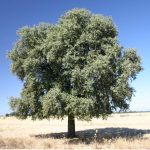 Also known has holly oak, this evergreen tree is native of the Mediterranean region and belongs to the beech family, Fagaceae, that also includes chestnut. The tree grows up 40-70′ tall and wide from a taprot and has many low hanging branches and a dense rounded crown. The bark is gray to black and the leaves are lanceolate to ovate, up to 3″ long, and dark glossy green with downy gray undersides. When young the leaves have toothed margins like those of holly, but as the leaves age the margins become entire. Small greenish yellow male and female flowers appear in spring on the same plant. The female flowers are in small clusters while the male flowers are in pendulous catkins. The fruit is a 1.5″ wide acorn enclosed in a cap that has downy scales and covers 1.3-1/2 the acorn. The fruit ripens in the fall. Holm oak is a good choice for a shade tree and street tree, and can be pruned into a hedge. It is tolerant of saline soil and wind so can be used in a coastal garden. The genus name, Quercus, is the classical Latin name for oak. The specific epithet, ilex, is the classical name for holly, and refers to the resemblance of the oak’s leaves to holly leaves.
Also known has holly oak, this evergreen tree is native of the Mediterranean region and belongs to the beech family, Fagaceae, that also includes chestnut. The tree grows up 40-70′ tall and wide from a taprot and has many low hanging branches and a dense rounded crown. The bark is gray to black and the leaves are lanceolate to ovate, up to 3″ long, and dark glossy green with downy gray undersides. When young the leaves have toothed margins like those of holly, but as the leaves age the margins become entire. Small greenish yellow male and female flowers appear in spring on the same plant. The female flowers are in small clusters while the male flowers are in pendulous catkins. The fruit is a 1.5″ wide acorn enclosed in a cap that has downy scales and covers 1.3-1/2 the acorn. The fruit ripens in the fall. Holm oak is a good choice for a shade tree and street tree, and can be pruned into a hedge. It is tolerant of saline soil and wind so can be used in a coastal garden. The genus name, Quercus, is the classical Latin name for oak. The specific epithet, ilex, is the classical name for holly, and refers to the resemblance of the oak’s leaves to holly leaves.
Type: Evergreen tree
Outstanding Feature:Foliage
Form: Rounded crown
Growth Rate: Slow
Bloom: Small yellowish green male and female flowers on the same tree, the female in small clusters, males in dangling catkins; spring
Size: 40-70′ H x 40-70′ W
Light: Full sun to part shade
Soil: Fertile, medium moist, well-drained; tolerants some drought and salt
Hardiness: Zones 7-10
Care: Prune for hedge ifdesired
Pests and Diseases: Generally healthy but susceptible to a large number of pests and diseases including borers, caterpillars, galls, leaf miners, nut weevils, oak lace bugs, oak skeletonizer, scale; anthracnose, cankers, chestnut blight, leaf spot, oak leaf blister, oak wilt, powdery mildew, shoestring root rot
Propagation: Seed (difficult)
Photo Credit Wikipedia